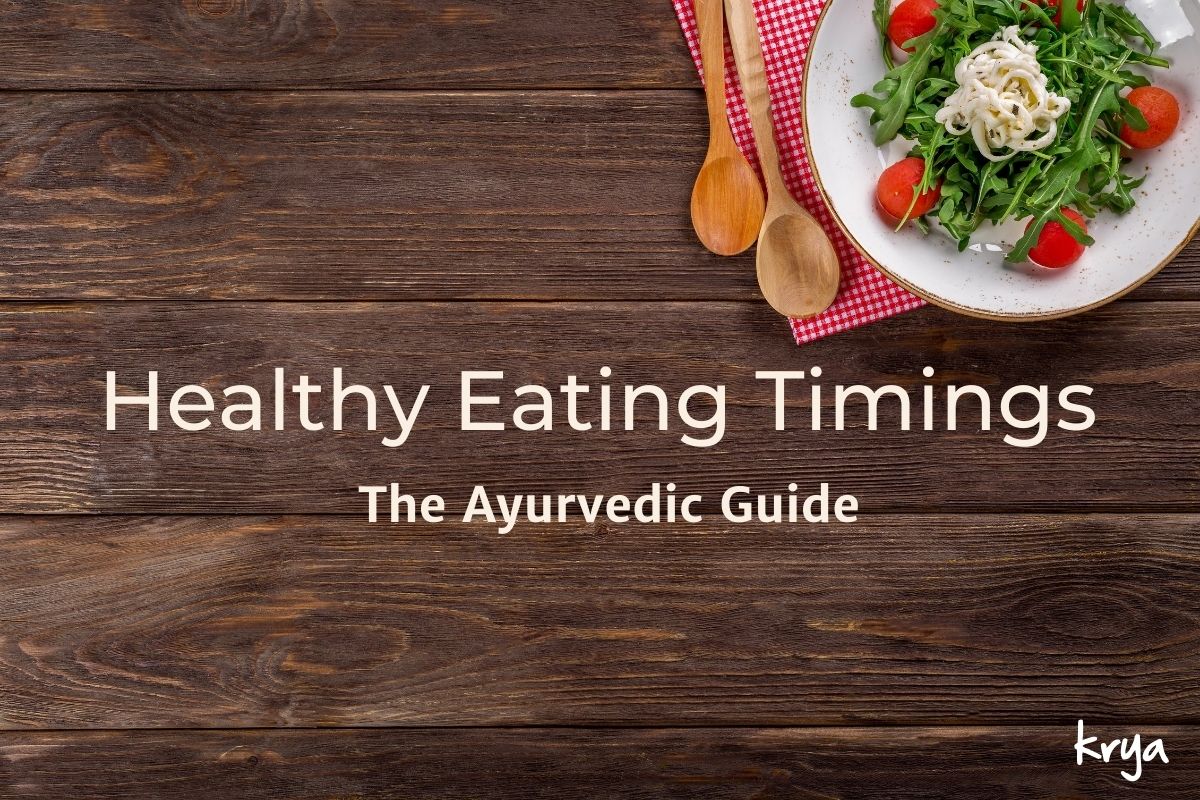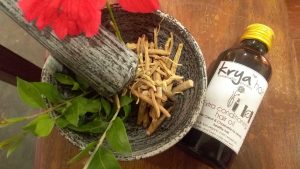This post was last updated on August 9, 2022 by Preethi Sukumaran
A common question we get asked at Krya is about healthy eating timings & habits to follow and meal choices at each time. Today, the media is charged with advice on nutrition and the importance of developing healthy eating habits. Often, these so-called studies also become quite contradictory, and we naturally start looking for some genuine and time tested guidance on on ahara (food) and ahara niyama (dietary practices to observe).
A key part of ahara niyama (or healthy eating habits) in Ayurveda is to identify the proper/healthy time to eat. This influences our capacity to digest food and extract nutrients from the food. In fact, choosing the correct time to eat each meal has the same effect on our health as choosing what to eat. In other words, we should spend the same amount of time planning when to eat as planning what to eat.
In this post, we are going to see why Ayurveda pays so much attention to meal timing and how this is a key part of developing healthy eating habits.
Planning healthy eating schedule: Different doshas influence different dayparts
Ayurveda tells us that each day is divided into 4-hour dayparts. Each of these dayparts is connected to the slow rise, peaking, and then falling of a particular dosha in our body.
The strength of the surge in the dosha depends upon the movement of the Sun. For example, if there is sunshine during the kapha period, the effect of kapha will be slightly reduced. Similarly, if there is good sunshine, say during a pitta part of the day, pitta will be much more aggravated due to the influence of the Sun.
In order to take advantage of these natural surges in a particular dosha, we are advised to do certain activities during certain parts of the day. Our body’s internal workings also take advantage of the dosha surges along the course of the day. Building healthy ayurvedic eating habits would include ensuring we do not at or sleep at at inappropriate times . Both of these tamper with the bodys internal clock. This is the importance of cultivating ayurveda approved habits like eating at the right time. This ensures our body is always working to ensure that we stay in good health and harmony.
Examples of Ayurveda approved healthy eating habits
One example of this is to utilise the right day part to do the correct activity. Waking up during the vata part of the day and eating during the pitta part of the day is an excellent thing to do. Pitta-influenced parts of the day are ideally suited to digest and process food. Hence, a pitta daypart is ideal for our heaviest / largest meal.

Similarly, waking up during the vata part of the day ensures we are able to utilize the creativity, enthusiasm, and high energy that it offers us.
This is why our Acharyas recommend waking up during Brahma Muhurtha (A 48 minute period that starts 96 minutes before sunrise). By design, Brahma Muhurta occurs after the peak surge plus a gradual drop of vata dosha. Waking up at this time, therefore, gives us high energy, mental clarity, and freshness throughout the day. In fact, many commentators say that waking up during this time allows for a “dosha re-balance” that is close to our natural state.
Choosing the correct Pitta daypart for important meal times
Pitta dosha and its various branches cover various activities; kindling an appetite, producing saliva and gastric enzymes, digesting and absorbing nutrients, and separating the food into useful and non-useful by-products that eventually leave the body.
Pitta dosha is strongly influenced by the Sun, as agni (fire) is one of the two pancha mahabhutas that make up the pitta dosha. Therefore, when the Sun reaches its peak, around noon, with maximum agni, the pitta in our body is also at its peak.
So, ideally, the correct time for our heaviest meal should be at noon. But here comes a problem. Traditionally, we ate ONLY one or two meals a day. In fact, in many Ayurvedic texts, the ideal number of meals is described as two. Connected to these two meals and the water we drink, we are also advised to have two to three bowel movements per day and six urine movements.
However, in modern times, this has been stretched to three meals a day, with a couple of snack breaks in between. Today, we usually eat breakfast around 8 AM, we eat meals like lunch around noon, and dinner again around 8 PM.
But you dont just eat your meals, do you?
We further graze on snacks, junk food, or blood sugar spiking fruit juices in between lunch and dinner. Or, if we have busy mornings, we reserve the largest meal of the day for dinner, or catch up with friends over the weekend for a heavy dinner.

When we compare what we do to shat we should be doing, we see that we may be overloading our body with unhealthy eating. This may lead to pitta imbalance. Over time this can impair digestion, resulting in a build-up of ama (undigested food) in the body. When ama builds up, it weakens the digestive fire thereby affecting energy levels, circadian rhythms, etc.
How to utilize the 2 pitta day-parts every day to pick the right times to eat ?
Ayurveda tells us that there are two parts of the day when the pitta dosha is strong; between 10 am – 2 pm in the morning, and between 10 pm – 2 am at night. The first pitta day part peaks at approx. 12 noon, and the other at 12 midnight. As the second pitta peak at midnight is dampened by the absence of the Sun, the BEST and MOST IDEALLY STRONG digestive agni occurs at noon, in the daytime.
So we should schedule lunchtime for the heaviest meal, as close to noon as possible. At this time, if we eat the right ahara for our prakriti, there is the greatest chance for this food to be well digested and properly absorbed with high nutrient retention inside the body.
What happens during the second Pitta daypart at night?
In normal circumstances, the body utilizes the pitta peak at midnight to “tune-up” pitta organs like the liver and spleen. This repair , maintenance, resting and renewing activity is ONLY done if digestion is fully complete. And, it takes the body 3-4 hours to digest a single meal completely.
So, if we have a heavy meal, a meal improper for our prakriti or rtu, a meal with high amounts of Guru foods (like sweets, curd, and red meat), or if Agni is impaired from following the wrong ahara niyama, this maintenance activity becomes impaired. Habitually following such practices will impair your metabolic health , put the organs under severe strain, and the body in an unhealthy state.
Since the ability of the body to digest is weakened severely post sunset, we are advised to have the lightest meal of the day as dinner, and NOT the heaviest as is ritually the case with many of us. It is also wise not to eat out for dinner, experiment with new cuisines (which may be heavy/difficult to digest) or eat socially (as we tend to overeat in these situations). Instead, we can reserve these activities for noon, when our digestive fire is at its peak and our body has the ability to digest such experimental meals.
When to eat breakfast – utilising the morning Kapha period
In the normal course of events, we have only one pitta rich daypart to eat and digest a meal properly. Our other two meals of breakfast and dinner are BOTH in kapha dominant dayparts. They occur at 6 a.m. to 10 a.m. , and 6 p.m – 10 p.m. , respectively.
Kapha aggravation can produce mandagni (reduced digestive fire), tamasic thoughts especially when food is tamasic, sloth, laziness, and weight gain when ahara is improper.

In cases of mandagni, the agni is in a doused and weak condition. Its ability to digest food and absorb nutrients is extremely poor. So even if we design a meal plan and eat the healthiest and best food , when we are in a state of mandagni, it will be of little use to us. The food will only be partially digested and the body will generate ama. Ama will putrefy inside the system and cause bloating, inflammation. It will also reduce the appetite and increase the heaviness in the body.
The evening kapha period when we have dinner is far worse than the morning kapha period when we have breakfast. The morning kapha period is weaker because of the presence of the Sun and increased activity on our part. That’s why we have less trouble digesting our breakfast compared to digesting our dinner.
Ahara Niyama (Eating Guidelines) as per Ayurveda
Here is an Ayurvedic recommendation for meals:
Breakfast moderately, lunch well and eat dinner very sparingly.
To repeat: Eat a moderate breakfast, a good lunch, and a sparing dinner.
Avoid any fruits, or even healthy snacks between meals, unless there is good hunger and appetite. Do NOT eat because you have read that eating 6 small meals is healthy or that it is good for you “to graze”. Grazing animals have a completely different digestive system – we cannot follow their method of eating throughout the day.
Ayurveda tells us that ideally all meals should be freshly made and hot. However, because both our breakfast and dinner are eaten during a kapha surge, please eat food that is freshly cooked and hot. At these meals, the body’s ability to digest stale meals is impaired. Stale meals are heavier according to Ayurveda. So they are more difficult to break down and can quickly aggravate kapha.

Eat a light breakfast within 9 am everyday. This can help you maintain a healthy gap between breakfast and lunch, allowing the body time to process the meals well.
During breakfast and dinner, avoid kapha rich foods like sweets, cakes, sweet fruits, meats, and curd. Also, avoid cold/ refrigerated food and cold drinks. If you’re using leftover rice from the morning, we advise that you re-wash and re-steam the rice to remove some of its gurutva (heaviness). This can help your body digest the food better. Ensure you add a small amount of high-quality, healthy fats into every meal for enhancing digestion.
Avoid difficult-to-digest food like raw food, highly complex cereals, and heavy lentils like rajma and channa for dinner. You can eat them in very small quantities occasionally at breakfast, only if the digestive fire is good and the activity level is high.
Choosing healthy eating timings: Recommendations by Prakriti
Healthy eating habits for Kapha leaning prakriti
If you have a kapha leaning prakriti or kapha aggravation, (weight issues, poor hair growth), we suggest that you eat dinner as early as possible within the evening kapha cycle.
For example, eating at 7 p.m. means that only one hour has passed in the kapha cycle of four hours. But, eating at 9 p.m. means that the body has had three hours to accumulate kapha. Eating your meals at the right time, not only helps you digest your food. It also ensures you avoid any blood sugar spikes, heaviness or bloating.

Apart from eating as early as possible, give your body light, well cooked and warm food. It should be devoid of kapha aggravating foods like oils, nuts and seeds, and sweet foods.
Deepana & Pachana herbs that are recommended for Vata prakriti can also be used for those with kapha prakriti.
In addition, mildly sour foods can help you feel hungry and reduce mandagni. To add sour taste, flavour our food with kokum, lemon, a small amount of ripe tamarind, and such. Well churned, well-diluted buttermilk can also be taken at night.
Further tips to help Kapha prakriti: the body responds well to activity and movement – this further positively impacts digestion and absorption.
Healthy eating habits for Vata leaning prakriti
Vata leaning and vata aggravated individuals have vishama agni (inconsistent agni). Often, they also have weak and dry hair, and poor skin texture. They suffer from bone and joint aches, abnormal skin darkening, gas, bloating, and such. Their appetite and ability to digest food vary greatly from day to day. So, apart from ensuring that dinner is eaten early, these individuals must avoid vata aggravating foods like breakfast cereals, granola bars and millets that are dry, crisp and light. Most importantly, those with vata prakriti also need to train their agni and bring it under control.

Such individuals need to eat deepana (appetite kindling) and pachana (digestive) spices. They can have include maricha (black pepper), pippali (long pepper), sunthi (dry ginger), jeera (cumin), curry leaves, hing (asafoetida), black salt (in small doses), and saindhava lavana (rock salt) in their diet.
Their evening meal should be freshly cooked, hot, light, and appetizing. They must eat this food at the same time every day as a habit. If they follow these practices, their vishama agni will be under control.
Dry Frizzy Vata type hair? Explore products below. ⬇️
Healthy eating habits for Pitta leaning prakriti
Pitta aggravated/ pita leaning individuals are very sensitive to changes in eating timings. They are most affected by improper dinner timings. Such individuals suffer from premature greying, hair thinning, gastritis, acidity, anger management issues, blood pressure, acne, skin sensitivity, and sunburn.
Why is late dinner so problematic for pitta-leaning individuals? We often find that such individuals never have a problem with appetite, but when they eat late, they develop gastric, acidity, and sour belching. This is because of two reasons;
- The later they eat in the kapha cycle, the more they need to utilize the pitta energy to combat Kapha upsurge. This is already high in pitta-leaning people, so they will extract MORE pitta energy simply to digest their food.
- After the kapha cycle, the second pitta cycle begins around 10 PM. If pitta-leaning individuals eat at, say 9.30 PM, the body will use the second surge in pitta for digestion. And, the repair and regeneration of important pitta parts like the liver and spleen will not take place.
Pitta leaning/ aggravated individuals do very well when they have a fresh, warm meal around 8PM. It also helps if they avoid any pitta aggravating dravyas like fried/ oily food, sour food, salty food and such.

They can follow this up with a glass of hot water around 30 minutes before sleep. This will clear the stomach and aid in the elimination of toxins from the body. However, remember that hot water should not be had very late in the night and strongly into the Pitta night period. This can re-stimulate the pitta dosha. We suggest doing this at the beginning of the pitta daypart or earlier, depending upon your eating timing.
If you’re interested, we have written a longer post on pitta balancing rasas and foods to consider in pitta prakriti.
To sum up: healthy eating habits & timings for all based on Ayurveda
We hope you found this post on choosing healthy eating timings as per Ayurveda useful. We also hope that this post gave you easy-to-implement practices in both your selection of food and meal times based on your prakriti. Food is key to all health and well-being in Ayurveda, and eating the right food can nourish and support you.
An ideal suggestion as per Ayurveda is to eat by 7 PM, and go to sleep BEFORE the second pitta surge starts at 10 PM. This is most ideal for rest, recuperation, good sleep, and energy the next morning. If this is not possible, we must at least avoid eating close to 10 PM and try to complete dinner around the halfway mark of the Kapha period, which is 8 PM.
Apart from when to eat, and what to eat, another important part of eating is how to eat. Watch out for this in an upcoming post.
We often say that Ayurveda is a holistic, health-giving science. As we can see in this post, the Acharyas have thought through every aspect of human existence and have given painstakingly accurate, logical, and holistic suggestions to maintain health and well-being. If you have any questions on this please email us. If you need help selecting the right Krya products for your ayurvedic skin or haircare journey, do contact us by clicking on the link below.









Thank you so much. Awesome! It’s really helpful. Simple and knowledge bearing. Thanks again.
Thank u so much…Really helpful post….seems we have been leaving a wrongful life…Thank u for making it so simple to understand…Will definitely follow & make changes in the routine…The symptoms u mentioned I already have…Obesity,,acidity,,,hairfall,,fatty liver & now pre diabetic stage…Thanks a ton for this post…
Loved this…
I find all dosha symptoms matching me whenever I see this hair and skin issues described. However the 2 meal cycle of lunch and dinner is what my family used to do. Post marriage, breakfast came into my life 🙂
Thanks Shuba – yes dosha symptoms can be sometimes confusing – also remember we are all usually a mixture of 3 doshas although texts have described people with single dosha and two doshas alone – but practically today we all contain 3 doshas – so it is possible we may see a few symptoms of each – i think it is important to note tendencies – what kind of food am I most drawn to? How do I react usually? What energises me? What tires me?, etc – the answers to these questions will throw up an accurate reading.
Hi, can you tell me what are the exact timings for two meals a day and one meal a day according to Ayurveda?
Hi Krishnakumar,
For 2 meals a day, the recommended timings really depend upon where you live. It is to be had as close to peak sun activity – so if 12 is when sun is at its peak, it is good to have lunch between 11 – 12, so the body utilizes the rising pitta energy.
The evening meal must be had as close to sunset as is possible but only after sunset. So generally 7 pm – 8 pm is a good slot. Also the meal timings you choose must not be drastically different from current meal timings – the body must be slowly trained to new timings.
Hi
Plz tell me traditional eating habits and timings.i believe in our ancient system.today wht we are following is not correct
Hi Remya: the post details traditional eating habits and timings. Do you have any further questions on this?
Yes mam,confusion stil our tradition is 2 meals or 3 meals.,im pitta kapha prakriti,which one wil suit me
Hi Remya: If you are eating 3 meals, it is not wise to suddenly cut it down and make it 2 meals. Ayurveda advises that all change be done only progressively. Instead I ask you to examine other aspects of your meals: what time is it eaten in, what food is chosen, whether this is suitable for your prakriti, how it is eaten, etc. Small measured steps can help health much more than large, hasty steps.
In traditional times, we ate ONLY one / two meals a day. In fact in many ayurvedic texts, the ideal number of meals is described as two. Connected to these two meals and the water we drink, we are also advised to have 2-3 bowel movements per day and 6 urine movements.
That 2 ideal meal time plz say
It should be lunch and dinner
Or breakfast and lunch?
Sorry for disturbing and confusing
I have not much knowledge about this
Thanks for answering
Hi Remya,
The 2 meals are a brunch – 1st meal eaten around 10:30-11 and dinner around 6:30-7. In addition depending upon work load, milk, or fruits can be taken in the evening or if you are waking up early in the morning.
Helo mam,
Iam really confused on this. Please clarify me. If we follow 2 meals a day, then where should we accomodate fruits, nuts in our dinacharya. Also, there are restrictions on food combining too like no raw and cooked foods together. So fruits nits dry fruits are considered natural food. So can we take it along with lunch. Iam always confused on this, as i have seen som people eating cooked foods like idly dosa, a fruit or fruit salad and few soaked nuts in the breakfast. So is thia correct? Because different foods needs different enzymes to digest. So how can we fo lik this? Please explain. Even when we were childrens, we used to have only 2 meals and in the morning it wil be a drink mostly milk or coffee. Only after became little older, started with breakfast concepts. So now people say like have breakfast and one fruit as mid morning snack, then lunch and sundal/ nuts for mid evening snack and then light dinner. But really we dnt feel hungry in between unless untill we do some heavy work. So if we can skip all those and follow only 2 neals a day, then where should we include our fruits/ nuts here? Iam so confused . Please clarify
Hi,
no restriction on taking sweet fruits in the beginning of the meal. Alternatively sweet fruits and soaked nuts can be taken in the morning , if you are hungry and brunch meal can be taken around 10:30-11:00 am. Fruits should not follow a cooked meal – – it also depends upon the fruit. Ideally there should be a gap of 30 minutes between fruits and a cooked meal. IF small amounts of heavy, sweet fruits are to be taken, then they can be served in the beginning of the meal also.
Also , please throw lights on nuts dry fruits .. which are heat producing and how should we consume like soakinh overnight or eating it dry as it is?
Yes, Dry fruits should be ideally soaked and eaten – they should be eaten according to season and prakriti. Many dry fruits are high in pitta energy (eg: cashew, pista), so the correct type of dry fruit must be taken by each one according to their body time. Also as we are in summer, digestive energy is severely strained – eating heat producing dry fruits can further decrease strength.
I really appreciate the way you simplify the concept and present the subject very gracefully. I am also M. D. in Ayurveda. I was think the same way how we should eat, Acharya gave us hints, we need to figure out the right meaning. Overwhelming information about diet in present time, even though recommended by some ayurveda practitioner are hard to gulp. Your’s views are amazing . I love it. Thanks for your blog.
Thank you so much Doctor!
Thank you for sharing your ayurvedic understanding. Most interesting and helpful! Linda
Thanks Linda!
Mam, Thank you for sharing! Great knowledge expressed in such a simple way.
Request you to write a blog about “How to know one’s body type and the percentage?”
I think I have Kaph and Vatt body type. Please reply am I right?
Do u suggest sth?
*Generally in the morning- my throat gets coughed (especially in winter)
* without exercise I feel lethargic
* I suffer from Shoulder pain sometimes (when I eat Vatta Prakriti foods, sometimes I can feel sensations on my back)
* A little imbalance in timings or no of servings leads to gas
* I don’t feel thirsty (Delhi)
very informative i find all the reasons for my digestive problems ! pranam to your parents and thanks a lot to you for sharing so much valuable info.GMHegde
Can i have only fruits as dinner..?as it is light..by 8pm..Am having skin issues may be am pitta category
Sunetra:
Depends upon the fruits – and also your state of balance / imbalance. for example fruits like mangoes are not suitable for the night in general as they are sweet and heavy. But they may be suitable for those who are very emaciated or underweight. Answer depends upon your prakriti.
Hello,
Thank you very much for such an informative post. Can I include early morning breakfast(at 7am) and lunch(between 1-2pm) as the two meals a day plan?
Thanks in advance!
Rashmi: Maybe breakfast can be taken as a lighter meal – but do not skip dinner.
Hello,
Thank you for the informative post. Can I divide the 2 meals per day as breakfast(at 7 am) and lunch(between 1-2 pm)?
Any comment would be much appreciated. Thanks in advance.
Roshni: if you are used to breakfast, please continue to eat it – but make it a lighter breakfast so you have a good appetite to eat a good lunch around noon. Dinner, should also be slightly light. So you can consider breakfast and dinner as two half meals. But all changes should be made slowly so the body gets time to get accustomed.
Awesome informative post, thank you for sharing
I only Eat One Meal a day, Mornings and Evenings never work for me, so it’s between 12-4pm 🙂
Such precious informations!
I am trying to find the right balance for me. Could you suggest please?
I am a Vata -Pitta individual and I would like to get used to two meals a day.
If I eat at 10:30 – 11:00 and at 5:30 – 6:30 pm would that be fine?
And what shall I do when I get hungry around 3:30pm? Stay hungry and wait til dinner? Drink water? Have some liquid food like almond milk? Or have fruit? Or eat some solid food? How to get the body used to 2 meals without going hungry for too long and without loosing weight? I am already quite thin although I eat good amounts.
Thank you so much in advance!
Vata-type people may sometimes need more food – as long as digestion is good. Two meals are not recommended for everyone, especially not if you are already used to eating 3 meals. Dinner can even be stretched up to 7 (you should ideally look at going to sleep within 2-3 hours after dinner). In which case if you are hungry between lunch and dinner, you can definitely go for a snack in the afternoon – almond milk is not suitable through the year – fruits, a small snack, any reasonably healthy solid food may be eaten – what you eat entirely depends upon your hunger + agni levels on that day.
I was having 4 meals per day. I have pitta dosha and the 3rd meal which was the evening snacks(6/7pm). This 3rd meal was giving me stomach problems. Thus currently I’m trying 3 meals per day removing the evening meal. Can you please give tips on the meal timings on both 3 and 4 meals.
Please complete dinner by 7:30 pm – max 8 pm – this would mean that if you are really hungry a light snack could be had around 4:30 pm, and not later than that.
Hello I am a vata person 65 years old underweight with poor Agni.I f I eat breakfast I don’t feel hungry for lunch.I cannot wait till 10 am for my first meal.Can I just have fruit in the morning or will it increase vata as grains taken for breakfast take long to digest.Kindly advise.Thanks
You can have fruits, or soaked dry fruits and a glass of milk for breakfast. Please experiment with different things to see which combination suits you best
Is mango acceptable to be taken after waking? According to another source, Yoga Ratnakara says it cannot be taken in morning…? Please inform me. Thank you very much.
How can I contact you?
Kartik, you can write to us – [email protected] .
Why 2nd meal only after sunset?
What if taken at evening?? So that 3-4 hours pass & sleep by 9
All the Ayurvedic recommendations fall within the framework of overall living as per Dharma Shastra texts. So the evening Sandhya period ( the transition from day to night) must be spent in Sandhya Upasana ( prayers) by everyone as per their stage in life. During Sandhya periods, sleep, eating, vedic studies , sex are ALL prohibited. Moreover during the Sandhya prayers, it is important to have an empty stomach, with lunch fully digested, as prayers would involve steps like Pranayama, which can be done only on a empty stomach. Hence with these activities, it is better to complete the Sandhya rituals & eat a light meal after sunset. Assuming a 6 PM sunset time for ease of calculation, even if we eat by 7 PM it it is possible to get 2-3 hours for digestion before sleeping early. You are correct in mentioning 9 PM a a good bedtime – as the smritis mention, that the ideal sleep time is the 2nd & 3rd Yamas after sunset – Hope this reply helps
Amazing article with great simplification of Prakriti-based eating habits. Thank you for sharing this work.